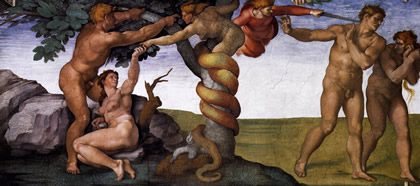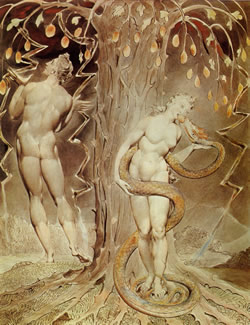Tempting Fate
First Sunday in Lent
A guest essay by Barbara Pitkin, Ph.D., Senior Lecturer in Religious Studies at Stanford University and the author of What Pure Eyes Could See: Calvin's Doctrine of Faith in Its Exegetical Context (1999). She is a member of Grace Lutheran Church in Palo Alto, California.
For Sunday March 13, 2011
Lectionary Readings (Revised Common Lectionary, Year A)
Genesis 2:15–17; 3:1–7
Psalm 32
Romans 5:12–19
Matthew 4:1–11
Two tales of temptation, each a prelude to a much larger drama. On the one hand, the first woman and man, yielding to the serpent’s lie in the garden. On the other, Jesus in the wilderness, resisting three times the devil’s propositions. Disobedience versus obedience. Each a catalyst within its respective narrative: out of the garden utopia and into the mess of human history; out of the wilderness and into the world. Together they raise up themes of disobedience, guilt, shame, brokenness, betrayal, denial, and suffering for pondering at the outset of the Lenten journey.
Yet, for Christians, these stories traditionally offer more than mere object lessons. In Paul's epistle, the two are related as “type” and “antitype,” and their protagonists have significance far beyond promoting restraint in the face of trial. Thinking of Jesus’ ultimate resistance of temptation in his submission to death, Paul concludes: “just as one man’s trespass led to condemnation for all, so one man’s act of obedience leads to justification and life for all. For just as by the one man’s disobedience the many were made sinners, so by the one man’s obedience the many will be made righteous” (Rom. 5:18–19, NRSV). Paul clips and splices, integrating the two tales into a unified narrative of human fall and redemption. The fate of one in the face of temptation held up as the fate of all.
 |
Michelangelo, “Fall and Expulsion of Adam Eve” (1510). |
In Paul’s harmonizing and universalizing, however, much material ends up on the cutting room floor. Most conspicuously absent, of course, is the woman. Arguably the central character in the Genesis account, her participation is eclipsed in Paul’s recasting of the incident in Romans. The man is the sole source of condemnation, sin, and death; Jesus the source of life. Quite the ironic twist, in light of both her leading role in the transgression of the divine command and the meaning of her name, Eve, “source of life” (cf. Gen. 3:20).
Not that Eve would necessarily mind the oversight. Paul’s expunging of any reference to her might be preferable to her fate in some other Christian retellings of the Genesis tale. Ignoring Adam’s culpability, the author of Second Timothy declares, “Adam was not deceived, but the woman was deceived and became a transgressor” (2 Tim. 2:14, NRSV). Other early writers divide the blame more equally, but speculate that the serpent approached Eve and that she yielded because as woman she was more gullible, less rational, morally weaker, or more prone to wrong-doing. For some, she compounds her error by knowingly drawing her male companion into the crime, whereas he yields only because of his affection for her. In the early modern and modern periods, artistic representations of the scene, such as Michelangelo’s “Fall and Expulsion of Adam and Eve” (1510) and William Blake’s “Temptation of Eve” (1808) make subtle yet unmistakable visual connections between Eve and the serpent; following this trajectory, popular understandings frequently cast her in the role of temptress herself.
In recent years feminist engagement with the story of temptation in the garden has questioned whether these traditional explanations do justice to the Genesis narrative. Phyllis Trible, Mieke Bal, and Ilana Pardes resist the pull of earlier interpretive trajectories in order to uncover new views of Eve and her role in the story.* Though they by no means exonerate the narrative completely and, moreover, disagree over the whether and, if so, when, the text provides the seeds for the sexist readings that come to dominate, they amply demonstrate the ways that the tale wrestles with, among other things, issues of gender identity, character, and societal roles. Read afresh, the story limits the interpretive possibilities but does not set in motion a fully prescribed destiny for either of the characters.
Each year the season of Lent invites Christians to be part of a story — a story whose ending they already know. Jesus’ temptation in the desert inaugurates a journey that ends with the trial of the cross. What would it mean to live the story, however, without knowing the outcome? To resist the temptation, for the time being, of Paul’s forgone conclusion that Jesus’ destiny is to undo the effects of the original disobedience and instead follow the winds of fortune, without knowing where they will lead Jesus — or us? Is it possible, or even desirable, to experience Lent as a voyage into the unknown? Without knowing the destination, might we not get lost — or even lose ourselves — along the way?
When we read a story for the first time, we never know how it is going to end; even upon a second, third, fourth reading, we notice elements we had previously overlooked, aspects that affect how we experience the ending when we arrive there again. Each time we manage to find our way through, because in a really well told tale, although the journey can be different each time, the possibilities are, nevertheless, limited.
Canadian writer Alice Munro is one who consistently achieves the delicate balance between the fatedness of a narrative with the freedom of discovery—as a reviewer of her 2004 collection of short stories observes, “The third thing that is so compelling about RUNAWAY is a powerful sense of fate, chance, destiny—the exact word is unimportant.” We watch as Munro’s characters — complex, “endearingly ordinary,” and predominately female — lose themselves in myriad ways but also, ineluctably, through “often through devastating twists and surprises of plot,” cannot escape their appointed but unknown ends.
Munro’s “Trespasses” plays ironically with this, opening with what turns out to be the closing scene. The ring composition enfolds the tale of Lauren, her parents Harry and Eileen, and Delphine, an employee at a small town hotel. The reader has a dim sense of where the story is going to end up, but less a knowledge of what is going to happen and more an unspecified mingling of fear and foreboding. What brought these four characters to this place just “far enough” off the road, at midnight, in the dead of winter? Does this bode evil for Lauren, in the backseat, wearing her pajamas?
 |
William Blake, “Temptation of Eve” (1808). |
The ensuing narrative unfolds as a flashback that relates Harry, Eileen, and Lauren’s recent arrival in the town and their first encounters with the initially unnamed woman who works at the hotel. Harry, who has taken over the town newspaper, wants to write books and shares this bit of advice with his daughter: “The thing about life, Harry told Lauren, was to live in the world with interest. To keep your eyes open and see the possibilities — see the humanity — in everybody you meet. To be aware. If he had anything at all to teach her it was that. Be aware.”
Eyes wide open, like the man and the woman after eating the forbidden fruit, Lauren becomes aware of the mysterious, “oddly light” cardboard box among her father’s boxes of papers. Her interest in humanity leads her into a clandestine friendship with Delphine. The box and Delphine share a secret, and as Lauren begins to piece together the truth that binds them together, her own identity and fate are thrown into doubt. She no longer knows who she is: is she the child of Harry and Eileen? Or is she adopted, and is Delphine her biological mother? And the human remains in the box: do they belong to Lauren, Harry and Eileen’s adopted daughter, or to Lauren, their biological one? So distressed that she becomes physically ill, Lauren finally tells Eileen and then Harry, but goes to bed fearing that the revelation will lead to one of Eileen and Harry’s violent rows — fights that Lauren now suspects have to do with the buried secret that she has uncovered.
Instead, however, her actions lead to resolution, at least for the adults. Delphine comes for proof about the death of the daughter she gave up for adoption; Harry wakes Lauren and explains, finally, the whole story. But one chapter is still unfinished: “So tonight as a family,” he said, “tonight while everything is all wide-open, we are going to go out and do this. And get rid of all this — misery and blame. Delphine and Eileen and me, and we want you to come with us — is that all right with you? Are you all right?”
Standing in the snow, just far enough off of the road, each of the adults takes a handful of the ashes. Eileen begins the Lord’s Prayer, but Harry interrupts, “This is Lauren, who was our child and whom we all loved — let’s all say it together.” And they all do, ending with “And we say good-bye to her and commit her to the snow,” with Eileen adding hastily at the end: “Forgive us our sins. Our trespasses. Forgive us our trespasses.” The ending of the story for Lauren is more ambivalent. Like the painful burrs clinging to her pajamas, and then her legs and fingers, the words “hers” and “ours” stick painfully in her ears: is she not more than someone’s possession?
Mortality. Ashes. The desire to be rid of misery and blame. Prayers for forgiveness from sins, trespasses. These elements constitute the end of Munro’s story and the beginning of the Lenten one. Yet perhaps these familiar beginnings can open up an extraordinary journey, one that resists the temptation to take the usual path. One that is open to the possibility of losing one’s self along the way. Be aware.
* Phyllis Trible, God and the Rhetoric of Sexuality (Philadelphia: Fortress Press, 1978); Mieke Bal, Lethal Love: Feminist Literary Readings of Biblical Love Stories (Bloomington: Indiana University Press, 1987); Ilana Pardes, Countertraditions in the Bible: A Feminist Approach (Cambridge, Mass.: Harvard University Press, 1992).
Image credits: (1) BackToClassics.com and (2) FreeChristImages.org.





